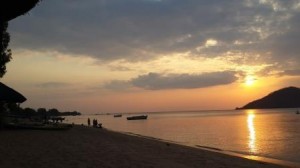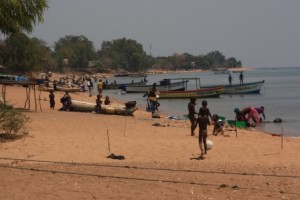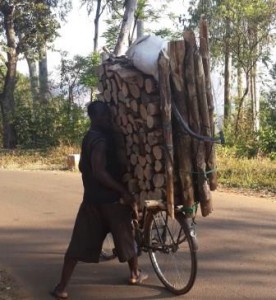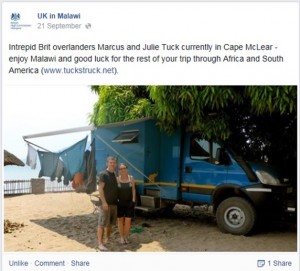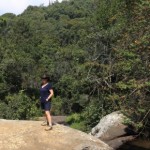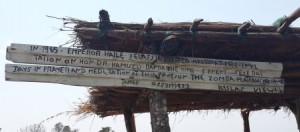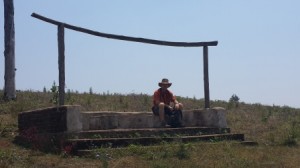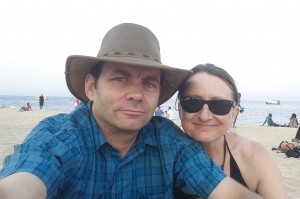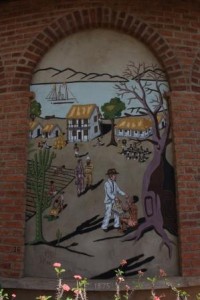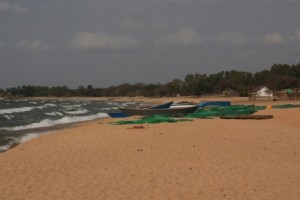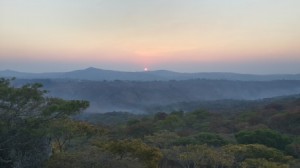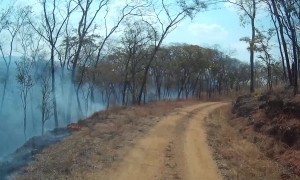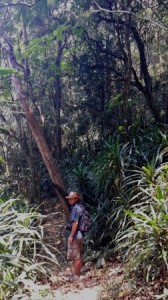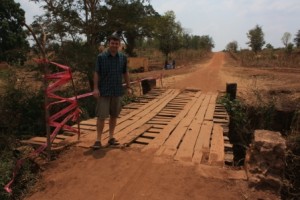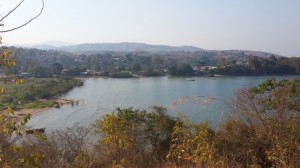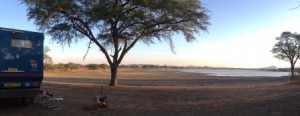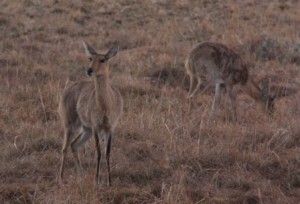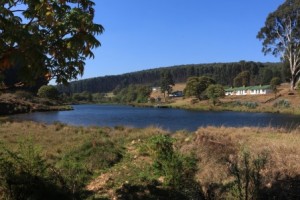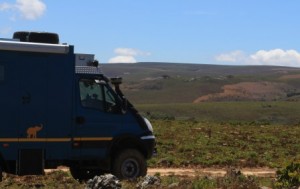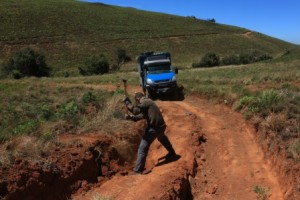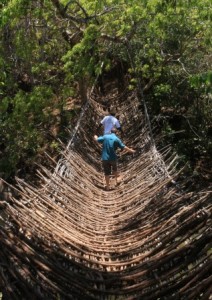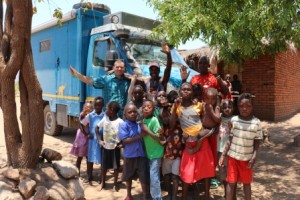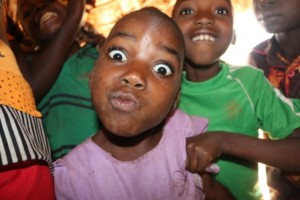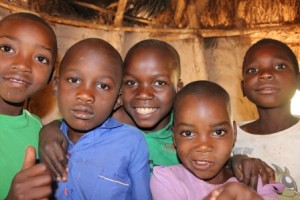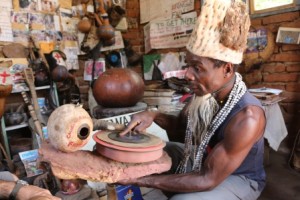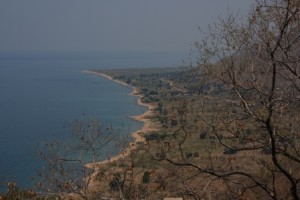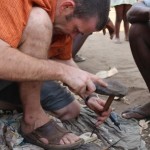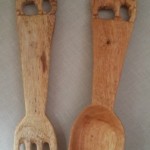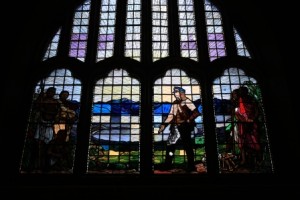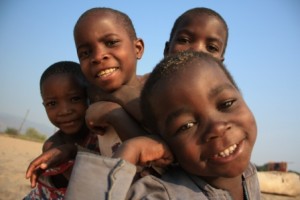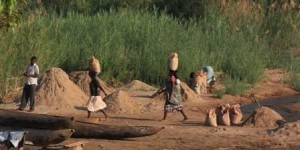September 2014
Malawi Overlanding Blog… More to Malawi than…
Apparently, the popular Malawian musician Esau Mwanwaya has released an album entitled: “MTMTMK” (More to Malawi than Madonna’s Kids)! We have read and heard so many good things about travelling in Malawi… beautiful country… friendly people… So we are really looking forward to checking it out… is there MTMTMK? 🙂 Here’s our Malawi overlanding blog
This is the second ‘new’ country that we have visited on this trip. Zimbabwe was also a new one for us and that turned out to be splendid! Just a bit of pressure on the people of Malawi then, to meet our high expectations 🙂 (Click here for our ‘end-of-Malawi’ ponderings on MTMTMK!)
After the easy border crossing, we headed straight down the main highway to the capital, Lilongwe. En-route, we stopped to try to get some local ‘blats’ from a village ATM (actually Malawian Kwacha, but we use this generic name for all currencies that we are not yet familiar with!). To do this, Cuthbert had to do a sharp drop off the main road tarmac into a rough lay-by. This manoeuvre was no problem for Cuthbert, but in negotiating the drop-down, we didn’t hear one of the top cupboards open-up in the back.
The consequences of this jolt became clear when we stopped later for our regular 11 o’clock tea and biccies: one carton of orange juice and one carton of long-life milk had fallen out of the top cupboard, split open and deposited their combined contents as two litres of curdled mess, swilling around the floor of our living cabin! We are now in a position to report that it takes no less than four washes with hot, soapy water to remove the hideous sticky residue and the smell of curdling milk, from Cuthbert’s flooring!
Whilst we were stopped at the roadside cleaning up the mess, a crowd of very young locals gathered around Cuthbert (tiny-tots, little more than toddlers!) shouting “Give me! Give me!” Hmmm…. we hadn’t had quite this reception in any other country so far! Maybe Madonna does have a lot to answer for!
Gourmet Lilongwe
The capital city of Lilongwe is not necessarily top of the list of many tourists’ itinerary in Malawi. However, one of our aims on this tour is to see many aspects of Africa, not just the countryside, safaris and national parks that most tourists come to see on their two-week holiday. Large towns are also for us, a good opportunity to do the sort of routine shopping that short-term tourists rarely need.
And the final reason to stop-off in the capital city, was to find a good restaurant to celebrate Julie’s birthday – a mission accomplished with an outstanding lunch at the Latitude 13 hotel. A grilled halloumi salad with pickled pears and walnuts, and a thai red curry, followed by strawberry and black-pepper cheesecake (sounds weird, but try it!) may not be traditional Malawian delicacies, but it was probably the most ‘gourmet’ meal we have had anywhere in Africa. Highly recommended if you happen to be in town and fancy a treat!
To the Lake
Obviously one of the main attractions of Malawi is its large fresh-water lake. It is the third largest lake in Africa and runs around three-quarters of the length of Malawi, down its eastern borders with Tanzania and Mozambique. We headed to Cape Maclear at the southern end of the Lake, reportedly one of the most beautiful parts of the shore-line, with good beaches that are safe from hippos and crocs.
The drive from Lilongwe down to the southern end of the Lake, via Dedza and Golomotti is a stunningly scenic drive over the mountains. Or at least it would be if it weren’t so murky! On the day that we drove, the distant views were sadly obscured by thick haze, but on a clearer day, the route is almost certainly one of the many spectacular drives of Africa.
Due to its very narrow streets, low trees and tiny lodges/camp-sites, Cape Maclear is a not a very ‘Cuthbert-friendly’ place. However we found a great spot that Cuthbert (only just…) fitted into, right on the beach. Marvellous! We could stay here for quite a while! In fact the young German couple parked-up next to us with their campervan, had arrived in the village eight months ago and still had no plans to move on!
We had a relaxing few days by the shore, did some scuba-diving/snorkelling, did a lot of sitting around and reading, and got to know a friendly (but just a bit crazy) Aussie couple travelling together through Africa on a motorbike! Respect!
Garmin brings Wallace back!
One piece of great news that we had on arrival in Malawi was the return of Wallace to our sat-nav! Cuthbert’s regular followers may recall that some weeks ago, back towards the end of our time in Namibia, our Garmin Montanna 600 Sat Nav was stolen (see Wallace is Kidnapped). With this we lost both our Garmin mapping, and our ‘Wallace and Grommit’ voice programme, which were all down-loaded and licenced by Garmin to the stolen device. At the time, we sent the police report off to Garmin, asking if we could have the mapping licence re-issued for a new Garmin Montanna 650 device, that we had managed to buy in Maun, Botswana (see A New Wallace). We didn’t have high hopes of Garmin agreeing to issue a replacement licence to us; after all, somebody somewhere was potentially using the original mapping licence that we had bought.
Although it took Garmin several weeks to respond (during which time we were naturally unimpressed with the lack of attention), they have now not only replied to our emails, but have issued a new licence to us, free of charge, for all our ‘old’ mapping and our ‘Wallace and Grommit’ voice programme!
No offence to ‘English – James’, who did a perfectly good (albeit rather humourless) job as Garmin’s ‘standard voice’ during Wallace’s absence, but we are now delighted to start our time in Malawi with the return of Wallace’s familiar voice and his encouraging advice to: “Keep-on keeping-on…”! Many thanks to Garmin for what, eventually, was a very fair service.
Cuthbert meets the Diplomat!
Relaxing is generally the order of the day by Lake Malawi, but at some point sadly, we still have do our ‘every-day’ chores such as cleaning and laundry. One Sunday by the Lake, we strung a washing-line up between Cuthbert’s awning posts and hung out our freshly washed laundry in the sunshine to dry. As we were doing so, we were approached by a charming English gent, who had noticed Cuthbert’s UK number-plate and came over to say ‘hello’.
Nothing unusual about that… except this turned out to be the British Deputy High Commissioner to Malawi! It was very interesting to chat to Martin and it turned out that we had mutual acquaintances from the British Embassy in Doha, Qatar! Rather unfortunately, the only picture that Martin could take of us for the ‘UK in Malawi’ Facebook page, displays Cuthbert, complete with all our laundry assembled on the washing-line! Definitely not the glamourous side of camper-van travel, but certainly a true reflection of ‘everyday life on the road’!
Serves us right…!
In our recent Blog about the different ways to travel Africa (see Horses for Courses… ), we explained slightly smugly, that in Cuthbert we have amongst our other luxuries: “our own reliable hot-water supply…”. Well. The very next day after publishing this, our boastful words ‘came back to bite us’ and we noticed a small leak in the hot-water boiler!! Cutting a long story short, Bocklet provided their usual impressively prompt support service and contacted the boiler manufacturer, Truma, straight away for help with the problem. After a bit of email to-and-fro, Truma agreed to provide the replacement parts for the boiler under the warranty, but in the meantime whilst we await the arrival of the parts from Germany, Marcus has used some radiator repair compound to temporarily seal the leak in the boiler and reinstate the hot water supply. No major dramas… but yes, we have to admit, it does serve us right for boasting in the Blog! 🙂
Moving down south
We have a vague plan for our time in Malawi to see the south first, then loop back up past Lilongwe again, to see the north before crossing into Tanzania in a few weeks. So from Cape Maclear we headed down to Liwonde. Here we met an interesting English couple from Manchester whose ‘thing’ is to climb the highest peaks in each country that they visit. On this 3 week holiday they had reached the highest points of Zimbabwe, Mozambique and Malawi; all done either on foot or using public transport between main towns. Back in UK, their ‘mission’ for their weekends, is to visit the highest points in each county. A pretty cool focus for travel plans, hey?
On the roads in Malawi, we are finding the police road blocks to be no less frequent than in Zimbabwe. Quite what they aim to achieve with so many ‘routine’ traffic stops is a mystery to us, but they usually ask for drivers licence, insurance, and sometimes the vehicle import papers.
These checks never take long and we are not in a hurry, so our strict policy is to be very friendly, with an almost sickly and sycophantic level of ‘super-happy-smiley’ attitude: “Hello, good morning Sir, how are you today?” we call out of the window as Cuthbert draws to a halt alongside the officers. This super-friendly and ultra-cooperative attitude occasionally seems to take them back slightly, but it provokes from them at worst an amicable approach to the document checking and at best, a wave-on through without any document checking at all. Although the frequency of these stops can occasionally be slightly frustrating on a long journey, it’s pretty tame stuff really – all part of the ‘African experience’ 🙂
Zomba
We haven’t yet established any firm answer to Marcus’ question whether people from Zomba are known as ‘Zombies’ 😉 But we have found Zomba to be a pleasant town in the south of Malawi, with good hiking on the Zomba Plateau nearby.
On a hike across the Plateau, we headed towards a view-point marked on our map as: ‘Emperor’s View’. Apparently the site is named after Emperor Heile Selassie of Ethiopia who visited the site back in 1965. At least the authoritative-looking sign said so… so it must be true! If he did come here, we hope for his sake that he had better visibility over the valley below than we did! Sadly for us (yet again!) the ever-present ‘Malawi Murk’ has spoiled our views! But we can see just enough of the views to confirm that they would be spectacular…. if only the haze would lift!
Zomba also has a lovely little garden-campsite on the hillside just outside town. Casa Rossa is run by a friendly Italian couple who serve delicious home-made pasta and other Italian food in their rural Malawi restaurant. A great find!
Lake of Stars
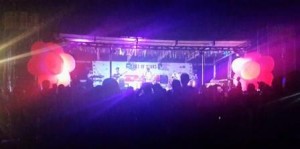 ‘Lake of Stars’ is an annual music-fest held in Malawi; we’ll call it a sort of ‘Africa’s answer to UK’s Glastonbury Festival… but without the mud!’. This year it is held at a beach resort near Mangochi and the timing was coincidental with our visit to that part of Malawi. For a few days we had been characteristically indecisive as to whether we should bother with this. We are not the biggest African music-gurus (or gurus of any kind of music actually!) so we didn’t recognise the names of any of the billed artists. Also we feared that in all probability, we would be the oldest hippies on the beach! After giving it a bit of thought, we decided that as we were literally passing the area on the day, it would be churlish of us not to give it a try and see another side of Africa.
‘Lake of Stars’ is an annual music-fest held in Malawi; we’ll call it a sort of ‘Africa’s answer to UK’s Glastonbury Festival… but without the mud!’. This year it is held at a beach resort near Mangochi and the timing was coincidental with our visit to that part of Malawi. For a few days we had been characteristically indecisive as to whether we should bother with this. We are not the biggest African music-gurus (or gurus of any kind of music actually!) so we didn’t recognise the names of any of the billed artists. Also we feared that in all probability, we would be the oldest hippies on the beach! After giving it a bit of thought, we decided that as we were literally passing the area on the day, it would be churlish of us not to give it a try and see another side of Africa.
We arrived early on Saturday afternoon as the day’s performances were just getting started, but Cuthbert’s entrance to the car-park did not get the event off to a great start for us! Hearing a loud crunch as we passed through the gate, we stopped sharply to establish that Cuthbert’s spare tyre on the roof had become caught on the overhead electric cables supplying the venue! Ooops! Who hung those cables at such a stupidly low height anyway? 🙂 Thanks to a nice policeman with a long stick, the cable was hoisted over Cuthbert’s roof and disaster was averted. Shame on you Cuthbert… causing a scene like that!
Anyway… after finding a good parking spot for Cuthbert, we went in to investigate the music. Obviously a cold beer is essential to enjoy a beach party on a hot afternoon, so the first stop had to be the bar! Then a tour of the three performance areas to see what it’s all about. Straight away we bumped into a young Irish/South African couple we had met in Zomba a few days ago. They explained that the programme was not running to plan and that we would need to check exactly when our favourite acts were on, so as not to miss them. We didn’t like to let-on that we had no ‘favourite acts’… mostly because we had no idea who any of them were!
So how was it? Well, without giving a detailed run-down of each act that we saw, we can generally say that there are some very talented acts out there: from Malawi, from wider Africa and from further afield in Europe. We enjoyed most of the acts that we saw, but particularly liked ‘Cable Street Collective’, a British group doing their own original material with an African vibe. There was another very good British band (Scottish actually, but now after the referendum, still British!) with talented singers and musicians. They were performing mostly covers of popular hits from other bands, but doing so rather well. We would just recommend to the female lead singer that she puts a little more effort into learning the words; it’s not a good look to be blatantly auto-cuing from an i-phone whilst performing!
During the afternoons, there were some lovely side-shows and we particularly liked some performances by a Malawian orphanage choir. Despite their significant disadvantages in life, and admittedly not an abundance of vocal talent, their enthusiastic and joyous performance was truly infectious and moving. They were a real pleasure to watch and for this performance alone, it was really worth us making the effort to go to the event.
At Lake of Stars we met Dan, a nice young English chap who is hitch-hiking around the world on his own. So far he has made it from UK, via Cairo down to Cape Town, then back up to Malawi to do some voluntary teaching in a school for a few weeks. After this he plans to return to South Africa, and by early 2015 he hopes to have hitched a ride on a ship from Cape Town to South America! We wish him all the best with this and hope to bump into him again at some point on his travels.
Senga Bay via Mua Mission
By Monday morning the ‘Lake of Stars’ venue was (understandably after hosting a 3-day music festival) slightly the worse for wear, with that look of a ‘morning-after- a-good-night-before’! We packed-up Cuthbert and headed north towards another popular lakeside area: Senga Bay. On the way we stopped off to visit the Mua Mission, with its interesting museum and series of murals depicting the history of Malawi. There we learned that many Malawian people today, can be genetically linked back to the original tribal pygmies that spread down overland from western Africa hundreds of years ago. Perhaps fortunately for the people of Malawi today, there is no longer any obvious physical evidence that they are descended from the famously tiny pygmy tribes.
One noticeable difference between Malawi and the more southerly African countries, is the nationality of other travellers that we have met. Further south it was predominantly Germans, with a smattering of other ‘main-land Europeans’ (e.g. Dutch) and obviously many South Africans. In Malawi however, we have met mostly British travellers. At the ‘Lake of Stars’ festival, the British accents of the other party-goers and the organising staff, far out-numbered any other foreign voices heard around the venue.
At Senga Bay we met a friendly, retired English couple en-route travelling around Africa. John and Sue had already travelled some of the route up into Tanzania and Kenya that we plan to do, so we had a very pleasant afternoon listening to their ‘travellers’ tales’ of the places we are heading for.
Similarly to us, they had shipped their vehicle from Bremerhaven to Port Elizabeth and were driving a round-route up to the Lake Victoria area and then back south. Not similar to us however, they are doing the journey in an ‘ordinary’ English road-touring camper-van. No high ground clearance, no off-road tyres, no four-wheel drive, low-ratio gears or diff-locks! John and Sue were clearly experienced travellers and had made several over-land trips in their camper-van around places such as the Baltic States, the Red Sea and North America. Nevertheless, we were left with an admiration for them bravely tackling long-term travel around Africa in a vehicle not ideally designed for the often very rough roads! Respect!
On our way north, we pulled into a Total petrol station and asked for Cuthbert to have both his tanks filled with diesel. “No” said the chap. “You need petrol”. “No, it takes diesel” said Marcus. “Oh!” said petrol chap, “this engine sounds too good to be diesel!”. Compliment to Cuthbert, we think!
October 2014
The Hills Again
One aspect of Africa that is becoming increasingly apparent on this journey, is that the further north we go, the less well stocked the food shops are! After failing miserably to find fresh (and particularly dairy) foods in the southern towns of Zomba or Mangochi, we decided to make a quick detour back to Lilongwe to restock our fridge before heading further north. With our essential supplies of cheese, milk, bread, gin and tonic suitably replenished, we headed north-east up to the Ntchisi Forest Reserve for a bit of mountain jungle hiking.
On the road up there we noticed again, as we had noticed further south around Zomba, a number of bush-fires burning across the countryside. It is now well into the dry season, there has been no rain for over 6 months and the bush-land is very arid in places. These fires are not the wild-raging, tragic forest fires as seen on TV from places such as Australia and California. These Malawian fires burn at a low-level, slowly, steadily, creeping across the bush-land, but seem to have insufficient heat intensity to ignite the larger trees. This leaves the occasional charred tree-trunk with green leafy branches, sitting in a patchy scorched earth of black-burned grassland. Waspish layers of smoke are left hanging around the scenery.
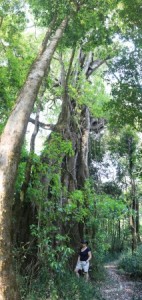 Once we were up at Ntchisi, it was great to be in the cool mountain air (or rather, cooler mountain air… it is still well over 30C during the day!) and doing some more short treks. The hiking trails in the Ntchisi Reserve climb up the hills and took us through dense jungle, with monkeys and baboons chattering and springing between branches, high in the tree canopy overhead. The whole scene looked suspiciously like the set of a Tarzan film!
Once we were up at Ntchisi, it was great to be in the cool mountain air (or rather, cooler mountain air… it is still well over 30C during the day!) and doing some more short treks. The hiking trails in the Ntchisi Reserve climb up the hills and took us through dense jungle, with monkeys and baboons chattering and springing between branches, high in the tree canopy overhead. The whole scene looked suspiciously like the set of a Tarzan film!
Occasionally there were breaks in the jungle, where the path came to an open space, with out-crops of rocks on hill-tops, for spectacular views over the valleys and down to Lake Malawi in the distance below. Or at least there should have been. Frustratingly once again, the prevailing haze (or as we are calling it, the ‘Malawian Murk’) has spoiled in spectacular fashion, what would have otherwise been stunning views. Apparently there is a high-pressure weather system over Malawi at the moment that is preventing the hazy conditions from clearing. This, combined with the smoke hanging around in the valleys from the bush-fires, is not conducive to the crisp, clear visibility that would allow us to show you some picturesque photos of Malawi! 🙁
A Bridge Too Far
Our guide book said that in order to get down to the Lake, it would be necessary to re-trace our tracks back some distance from Ntchisi to reach the main M18 road between Kasungu and Nkhotakota. T4A (our ‘Tracks 4 Africa’ map on the sat-nav) did not agree, clearly showing a network of tracks leading in a much more direct route, down the mountains to the lakeshore. Here we go then!
After around an hour of steep winding tracks, scenic villages, smiling waving children and pretty countryside, we came to a bridge.
As regular readers of this Blog will have gathered, we have been impressed with Cuthbert’s rough-road and off-road capabilities so far, but we have to admit one or two inherent but fundamental weaknesses of this kind of truck. At 3.3 m in height, we have once or twice had ‘issues’ with low branches on trees, not to mention the low electricity cables at the entrance to ‘Lake of Stars’ (see above)! Another weakness is the weight. At almost 6 tonnes fully laden, this had so far only once been a real issue for us: on a beach in Namibia, where we sank through a thick crust of dry sand into a watery sand-slush (see Cuthbert’s First Play in the Sand).
Today we faced the weight problem again: this time more predictably, with a small bridge over a sharp-deep river-cutting.
As we approached the shabby plank-bridge, we saw workmen constructing a new concrete bridge just to the right of the track. Unfortunately the new bridge was not yet quite ready for Cuthbert – it was the plank-bridge or U-turn. Decision time!
Marcus got out and inspected the bridge. We hesitated. The construction workers came over and were full of encouragement, adamant that the bridge was strong enough for Cuthbert. “Yes, come, come, no problem….” Hmmm. But it wasn’t only the weight that concerned us. The tyre-tracks over the bridge were only just wide enough for Cuthbert’s wheels. What’s more, the tyre-tracks didn’t align properly with the road, so if we were going to use the bridge, some diagonal manoeuvring was necessary to get Cuthbert lined-up with the tracks onto it.
We decided to give it a test: Marcus would edge Cuthbert’s front wheels onto the start of the bridge, whilst Julie watched the structure to see how it took the gradual weight transfer. As Cuthbert moved forwards, the workmen were shouting encouragement and waving directions for Marcus to align Cuthbert’s wheels with the bridge tyre-tracks. But as the wheels rolled slowly onto the planks, loud creaking could be heard from the structure under Cuthbert’s weight. It could have been just the surface planks pressing against the structural planks underneath. On the other hand it could have been the structural planks straining under Cuthbert’s weight. Either way, it was not a healthy sound. And the difference was not one which we wanted to find out.
Had the drop under the bridge been just couple of metres, from which we could have winched Cuthbert to safety if the worst happened, we may have risked the bridge crossing. But this was a deep and steep drop of around 8-10 meters. If the worst had happened, there is no way that Cuthbert could have been recovered in anything less than 100 pieces. It would have been a total write-off. To us, it was simply not worth the risk.
We thanked the workmen for their help, but decided that in this case ‘discretion is the better part of valour’ and retreated with a U-turn to find an alternative route down to the Lake. All you ‘Landy-with-roof-tent’ drivers out there can chalk-up another victory here! You would certainly have had no problem with this bridge 🙂
Speed-up or get an extension?
After a mercifully short detour of only around 10 km to avoid the bridge, we headed to our chosen Lake-side camp site near Nkhotakota. The slight snag as we approached Fish Eagle Lodge…… yes, another weak bridge over a small river just a few hundred metres from the entrance! So close but so far! Fortunately another campsite just down the road, this one without an access bridge, was the first of a series of four nice beach-campsites that we stopped off at along the central section of the Malawi Lake shore. Mostly due to the time spent lazing around the beaches, it took us a week to cover the 200ish kilometres between Nkhotakota and Nkhata Bay. No point in rushing these things is there?
In Nkhata Bay we did some exploring. Well we say ‘exploring’…… we mean we wandered around the bay to try the beach bars and meet people in the other lodges/campsites which are popular with travellers. The locals are also genuinely friendly and often have interesting names in the English language such as: ‘Innocent’ or ‘Peaceful’. Well we guess there are worse labels you could attach to people! One nice local chap introduced himself, with a totally straight face, as “Happy Coconut”. What can you say to that? (other than: “Pleased to meet you Mr. Coconut” 🙂 ).
Our reluctance to leave each beach that we visited, resulted in a very slow pace of travel up through Malawi. This in turn resulted in the realisation that if we continued at this pace, we wouldn’t reach the Tanzanian border within our 30-day Malawi tourist permit. So we had to either: (a) pick-up the pace considerably; or (b) get our tourist permits extended. Bit of a ‘no-brainer’ really……. off we went to see the nice chap in the Immigration Office at Nkhata Bay. Ten minutes and 5,000 Kwacha later (sounds a lot, but only around £7.50), we each had a month’s extension stamp in our passport. And relax! Now we have time to see more of the ‘in-land’ to the west of the Lake.
Can’t cut ‘pretty hair’
We headed to the northern town of Mzuzu for a bit of stocking-up the larder and to raid the cash-point for a few more Kwacha before heading to the northern hills. Near the Chipiku Supermarket (you know… that well-known chain-store brand!) there was a hand-written sign outside a small shop: ‘Hair cutter and taylor’. Marcus didn’t really need a suit making, but he hadn’t had a hair-cut for a while and it was rapidly reaching the length of pony-tail potential! Not being a fan of the ‘hippie look’, he decided to brave a local hair-cutter for a trim. “No, sorry” said the lady in the first place he went to “…you’ve got pretty hair, I can’t cut pretty hair”! We believe the appropriate popular ‘youth-text’ response to this is “LOL” 🙂
Next barbers shop in the market-place: “Yes Sir! Please sit down” as he picked up his electric cutter/shaver. Unfortunately it turned out that he had no ‘No.4’ or ‘No.3’ fitting for the shaver, so used a ‘No. 2’ instead. A bit shorter than Marcus was expecting. But at least it will be a while before he needs another cut!
Tsetse Land
North-west of Mzuzu, we headed for the national parks of Vwaza and Nyika. First the little-visited Vwanza Marsh Reserve. ‘Little-visited’ because although it has great game-viewing potential, it also has mosquitoes and tsetse flies. Right on cue, a few tsetses flew into the cab just as we were parking up! This caused us to think back to a particular afternoon in Doha, just over a year ago, around June 2013.
At that time whilst researching for our forthcoming short holiday in Tanzania, we learned that the colour blue is best avoided for safari clothing in the Serengeti as it attracts tsetse flies. On the very same day that we learned this interesting fact, we received an email from Bocklet with a picture proudly displaying the completed paint job on the new campervan they were building for us…. in our chosen shade of lovely blue! Ooops! Too late to change it now.
So now in Vwaza Marsh Reserve, we had the first chance to test Cuthbert’s ‘tsetse factor’. Was he the right shade of blue to attract a swarm of hideous biting flies, buzzing around us threatening the evil ‘sleeping sickness’? Well, within 5 minutes we had two in the cabin, but a quick swat and a spray of ‘Doom’ soon had them taken care of. After that, we saw very few and they did not cause a problem. Maybe lucky this time, but this is something we will need to watch out for as we head further north, especially in Tanzania. In any case, in Cuthbert we are about as well prepared for mossies and tsetses as we can be (excluding the colour choice of course!) with good quality nets fitted on the door, the windows and the roof hatches.
In Vwaza, with a few sensible mossie precautions, we had a perfect ‘picture-book’ African safari camp, parked-up by a small lake, sipping our sundowners whilst watching hippos, elephant, monkeys, impalas, kudu and warthogs. We enjoyed the dusk/sunset so much that we got up at sun-rise to see some more! “Wow… that’s keen!” you may be thinking. Well we must admit that it wasn’t the biggest effort in the world. We actually only had to roll out of bed, grab a cup of coffee and sit outside the door in our pyjamas to watch all the hippos wandering back into the water from their over-night grass-grazing on the shore. But had we been really lazy, we could have seen most of it out of the window from our bed inside Cuthbert!
I can’t believe it’s not Europe!
Just north of Vwaza is the Nyika National Park, sitting around 8,000 ft up on a high plateau. We decided to go and find out why the terrain is described in the travel books as ‘Europe in Africa’.
The rough track leading up the plateau is steep in places and takes around 4 hours from the nearest town of Rumphi, so it is not quickly negotiated for an easy day trip. It’s one of those destinations where you have to treat the drive to get there as part of the whole experience!
But when you get up there, it really is gob-smackingly like parts of Europe! The top of the plateau is covered with green rolling hills, dotted with wood copses and pine plantations. Not only is the landscape European, but the temperature is also pretty much European (well, summer European at least) with a high of mid-20s during the day and down to a chilly 10C or less at night. Only the roaming zebra, roan antelope, kudu and the occasional pile of elephant dung on the roads, convince you that you are in central Africa, only 10 degrees south of the Equator! Bizarre!
One of the best bits about our time on the Nyika Plateau is that, for the first time since we arrived in Malawi around a month ago, the ‘Malawi Murk’ has lifted! Or maybe it is still there, but at almost 2,500 metres we have risen above it…. whatever…! Finally we have great visibility of the lovely views!
There is plenty of wildlife around in Nyika, we saw lots of various types of antelopes (all generically known to us by the name of ‘goat’) and zebras. We didn’t see any of the leopards and hyena that area allegedly plentiful around the plateau. As this is a fairly remote Reserve, the animals are far less accustomed to vehicles and much more nervous than in other game parks. They stay some distance from the vehicle tracks and often run away if a vehicle stops anywhere near them. This makes them difficult to photograph without a very long lens, but we did manage to get a couple of piccies to prove they exist!
The driving around the plateau was mostly good quality dirt-tracks, but there were a few tricky sections where the track had been deeply rutted and washed-away in the rainy season. At one point we decided the best way to get Cuthbert through a very rough patch was to get out the shovel and pick-axe to back-fill the deep holes in the track. Cuthbert has an impressive 30 cm of ground clearance, but these holes were too much even for him! We hope that the next drivers (whenever they come – we didn’t see any other vehicles out around the park) appreciate our road-building skills to allow them to pass!
Topping out at 2,484m, this is the highest point that Cuthbert has ever been to (his previous high-point being an Andorran ski-resort earlier this year). We made a short video of ‘Cuthbert in Nyika’ to show some of the track conditions and the ‘European’ scenery.
The Basket Bridge
Returning back down to lower ground, we headed further north up the Lake shore, stopping off to see a basket-bridge over the South Rukuru River. A local character by the name of Mr Nyasulu is the guide for the bridge, which he does in a most entertaining manner, sporting a few pieces of traditional garb from the Phoka tribe. The bridge was apparently first built in 1904 and is still very much used by locals every day. But like the proverbial 20 year-old broom that has needed only 2 new handles and 2 new brushes, the bridge hanging there today probably has little, if any, of the original bamboo basket-weaving from over 100 years ago!
In a hut near the bridge, Mr Nyasulu has set-up a tiny but fascinating and entertaining cultural museum, full of traditional gadgets and interesting artefacts. These included a bizarre, home-made gramophone with a kalabash as an improvised amplifier/speaker… and it actually worked!
Together with the children from the village, Mr Nyasulu engages visitors on an ‘ad hoc’ basis and brings to life his tales of local culture with short, lively demonstrations, songs and dances. We spent an entertaining hour or so with them and highly recommend this as a short stop-off for other travellers in the area. The very small fee, plus whatever donation you wish to make, goes to support the local community.
Chitimba woodwork
Continuing our alternating mountain and Lake-shore stages of the Malawi journey, the next northern Lake-shore section was a few days in Chitimba. Not much here except a village and a lovely beach, but it is a popular stop-off for over-landers and a good start-point for trips up to Livingstonia.
The popularity of Chitimba with over-landers, particularly the large trucks of young westerners on a whistle-stop ‘see Africa in a month’ tour (Cuthbert followers may recall our previous ramblings on these travellers, see ‘Horses for courses…’), has generated some local industries. The main business for the ladies in the village is to take in laundry. Obviously no machines – all washed by hand at the Lake shore. To support the local economy, we gratefully handed over our very grubby clothes, deeply engrained with red dust from our road-construction activity a few days ago up on Nyika Plateau (see above). The ladies did a sterling job getting them clean! And as they were keen to get as much extra work as they could, we also gave them our bedding to wash. Probably not too many Orla Kiely designed duvet covers end up being hand-washed in the shore waters of Lake Malawi!
Whilst the women-folk of the village work hard in the sun at the Lake-shore laundry, the men seem to sit around the streets in the shade, with displays of wood-carvings and other tat-souvenirs spread out on sheets on the ground in front of them. A few of them sit with a small chisel and a lump of wood, claiming to have carved all of their wares themselves, although a comparison of the quality of the items on the ground sheet, and the hacked-up piece of wood in front of them, might lead a person more sceptical than ourselves, to question the validity of this claim 🙂 For Europeans old enough to remember, this trade in African wooden trinkets can be likened to the 1970s Spanish holiday sombrero and straw-donkey.
Occasionally on our travels we have seen the odd original, well-crafted piece that we admire; under other circumstances we may have been prepared to negotiate a price for the odd item to support local business. But travelling in Cuthbert we have to resist the temptation; we simply don’t have the space to store anything that we don’t use in our day-to-day travel. Much as we would like to support the village economies, Cuthbert would be straining under the weight of mis-shaped wooden lumps, vaguely resembling elephant or rhino, if we had bought a small trinket from each of the ‘craftsmen’ that we had come across so far.
In Chitimba we stayed at a very nice, Dutch-run campsite. Here it was suggested that rather than simply buying unwanted tat from the village stalls, an alternative way to support the village economy is to have a wood-carving lesson with their chosen local craftsman. He would help us to create some tat (sorry… ‘hand-crafted souvenirs’ 🙂 ) of our choice. OK… we had a spare afternoon so a bit of wood carving, or rather in our case, wood-hacking, could be interesting. And at least we could make something practical, that we could use in Cuthbert on our travels.
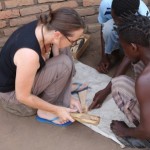 The picture shows the rather dubious results. We had a fun afternoon chatting to the locals and producing a very ‘rough and ready’ set of salad servers which make even the worst tat on the village stalls look positively high-end! We are sure you will agree that we should not, as the saying goes: ‘give-up our day-jobs’ to become wood-carvers. Or at least we wouldn’t if we had jobs to give up 🙂
The picture shows the rather dubious results. We had a fun afternoon chatting to the locals and producing a very ‘rough and ready’ set of salad servers which make even the worst tat on the village stalls look positively high-end! We are sure you will agree that we should not, as the saying goes: ‘give-up our day-jobs’ to become wood-carvers. Or at least we wouldn’t if we had jobs to give up 🙂
Livingstonia
High on the Rift Valley escarpment above Chitimba is the historic settlement of Livingstonia. No prizes for guessing who that village was named after. The steep, winding track up the sheer escarpment, with its narrow, barrier-less track is as much a reason to go there as the destination itself. It climbs around 900m in 9 km of road, including 20 hair-pin bends which are so tight that the last bend is only 4km ‘as the crow flies’ from the first one! Not for anyone lacking a head for heights. All the way up, we saw evidence of the breath-taking views so well described in our travel books, but yet again our visual experience was limited by the seasonal ‘Malawi Murk’ that we had encountered over most of the country 🙁 The video gives a bit of an impression of the route and the murky views.
We drove the steepest part of the route as far as the Mushroom Farm Campsite, then we walked the last 6 km on paths through some scenic valleys and villages, to the church and Victorian Mission on the top.
Despite the Murk, which we have now come to accept as a routine factor reducing our expectations of what would otherwise be spectacular views, we spent a great few days in the cooler temperatures on top of the escarpment, meeting other travellers and going on walks around the villages and to the Manchewe waterfalls. We almost got lost wandering around the rural footpaths between the banana fields. Luckily, Julie’s Teva sandals have a very distinctive sole-print in the dust, so we could do a bit of Boy Scout tracking, re-tracing the foot-prints back to where we started!
So is there MTMTMK?
After the descent from Livingstonia back to the Lake-shore, there is not much more to see in the far north of Malawi. Driving up the last leg of the M1, we are stopping-off in Karonga for food and fuel, then the last 40 kms up to the border with country No. 7 on our itinerary: Tanzania.
We entered Malawi five weeks ago wondering whether the local pop-star had got his album title right: “More To Malawi Than Madonna’s Kids”.
After extensive research and consideration, we have concluded that he’s not wrong! Malawi is a beautifully scenic country, with plenty to see/do and a level of friendliness to rival the outstanding welcome provided by the Zimbabwean people (which really blew us away – see Zimbabwe). It is peaceful and safe, with a low crime rate and, unlike its more popular neighbouring tourist destinations, it is refreshingly un-commercialised.
In terms of the financial wealth of the population, Malawi is certainly the poorest country that we have visited so far. Everyone seemed reasonably well nourished and there are fresh-water pumps with basic sanitation provided near the rural villages. The condition of clothing is often extremely raggy, in many cases barely hanging together by threads. And only very few of the rural people have shoes. We saw a man crouching down at the Lake-shore rubbing sand with his finger around his teeth to clean them.
The hard physical work seems to be done mostly by the women and sometimes, the children. They were the ones walking from the water-pumps to the huts with large water carriers on their heads – often upwards of 25 or 30 litres. And in Nkhata Bay we saw women digging wet sand out of the Lake-shore and carrying it away in large sacks on their heads, to sell to the building trade. In most Lake-side communities, the mens’ contribution seemed to be the fishing, but they didn’t seem to do the same hard physical graft that we saw the women doing. ‘Big Respect!’ to the ladies of Malawi!
So would we recommend a two-week holiday in Malawi and if so, why does Malawi not have a major tourism industry like its neighbours such as Tanzania and Zambia?
Well, yes we would highly recommend a holiday in Malawi for a fairly adventurous, independent traveller with an interest in seeing a very beautiful, friendly and truly genuine side of Africa. Malawi would very much appeal to this kind of tourist.
Malawi has a bit of everything. But if Malawi has a down-side, it is that in each of its many attractions, it lacks the ultimate ‘wow-factor’ of its neighbours. Malawi has several great game parks, but none with quite the density and range of animals that attract safari goers to say, Tanzania or Zambia. Malawi has very pretty beaches on the Lake, but none quite like the never-ending, deserted coastal beaches of the Indian Ocean, and the Lake has bilharzia in some parts which is obviously a concern for swimming. Malawi has scenic mountains for hiking, but not quite rivalling the scale of South Africa’s Drakensberg, or the challenge of Kilimanjaro. Malawi has fresh-water scuba-diving and snorkelling, but not quite as spectacular as that off the shores of Mozambique. And finally Malawi has some very beautiful scenery, but not quite as stunning as the vast, breath-taking landscapes of Namibia.
Having said all that, we leave this beautiful country on a very positive note having had a wonderful experience over the last 5 weeks. It is true that Malawi may lack some of the wow-factor that is so sought-after by the ‘cash-rich, time-poor’ holiday maker that we used to be. But in our view Malawi more than compensates for this with is wide range of attractions in a fairly (by African standards) small area, its exceptionally friendly and welcoming people, its safe travel environment and last but not least, its lack of commerciality. This is a truly genuine part of Africa which lives up to its own promotional label of ‘The Warm Heart of Africa’.
And yes, there is definitely MTMTMK!
Here is a quick overview map of our route in Malawi.
Tune in shortly to the new Tanzania page for further instalments of Cuthbert’s travels…
(Feb ’15: unexpectedly, we returned to Malawi on our southbound route heading back to South Africa. Click here to see Return to Malawi)

